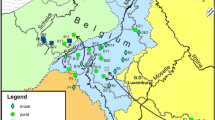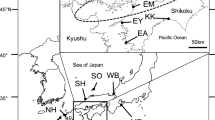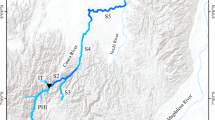Abstract
Establishing translocated populations is a common process to preserve and maintain genetic diversity of threatened species. In 2001, three translocated populations of noble crayfish (Astacus astacus) were established in the Czech Republic, founded by either adult or juvenile individuals from three particular source populations. We assessed genetic diversity at seven microsatellite loci after one decade (assumed three generations) from establishment. Although the translocated populations exhibited a slight but non-significant reduction in genetic diversity (A R = 2.2–5.0; H O = 0.11–0.31), the most striking result was generally very low genetic diversity in source populations (A R = 3.0–5.3; H O = 0.15–0.38). Similarly, a high degree of inbreeding (F IS = 0.36–0.60) demonstrates the nature of source populations, already affected by isolation and small size. In spite of that, based on the results of this study, the establishment of new translocated noble crayfish populations was successful, since there is no significant decline in genetic variability and all populations are still viable. Although source populations did not exhibit high genetic diversity, their distinctiveness makes them possible to use for conservation purposes. Continued monitoring is necessary to track the long-term progress of the translocation program, including other parameters describing the state of the population, such as the occurrence and frequency of diseases or morphological changes.
Similar content being viewed by others
References
Albrecht H (1983) Besiedlungsgeschichte und ursprüngliche holozäne Verbreitung der europäischen Flußkrebse (Decapoda: Astacidae). Spixiana 6:61–77
Bohman P, Nordwall F, Edsman L (2006) The effect of the large-scale introduction of signal crayfish on the spread of crayfish plague in Sweden. Bull Fr Peche Piscic 380–381:1291–1302. doi:10.1051/kmae:2006026
Bonhomme M, Blancher A, Cuartero S, Chikhi L, Crouau-Roy B (2008) Origin and number of founders in an introduced insular primate: estimation from nuclear genetic data. Mol Ecol 17:1009–1019. doi:10.1111/j.1365-294X.2007.03645.x
Buřič M, Hulák M, Kouba A, Petrusek A, Kozák P (2011) A successful crayfish invader is capable of facultative parthenogenesis: a novel reproductive mode in decapod crustaceans. PLoS One 6:e20281. doi:10.1371/journal.pone.0020281
Cardoso MJ, Eldridge MDB, Oakwood M, Rankmore B, Sherwin WB, Firestone KB (2009) Effects of founder events on the genetic variation of translocated island populations: implications for conservation management of the northern quoll. Conserv Genet 10:1719–1733. doi:10.1007/s10592-008-9774-z
Cornuet JM, Luikart G (1996) Description and power analysis of two tests for detecting recent population bottlenecks from allele frequency data. Genetics 144:2001–2014
Do C, Waples RS, Peel D, Macbeth GM, Tillett BJ, Ovenden JR (2014) NeEstimator v2: re-implementation of software for the estimation of contemporary effective population size (Ne) from genetic data. Mol Ecol Resour 14:209–214. doi:10.1111/1755-0998.12157
England PR, Osler GHR, Woodworth LM, Montgomery ME, Briscoe DA, Frankham R (2003) Effects of intense versus diffuse population bottlenecks on microsatellite genetic diversity and evolutionary potential. Conserv Genet 4:595–604. doi:10.1023/A:1025639811865
Frankham R (1995) Conservation genetics. Annu Rev Genet 29:305–327. doi:10.1146/annurev.ge.29.120195.001513
Frankham R, Ballou JD, Briscoe DA (2002) Introduction to conservation genetics. Cambridge University Press, Cambridge
Gherardi F (2006) Crayfish invading Europe: the case study of Procambarus clarkii. Mar Fresh Behav Physiol 39:175–191. doi:10.1080/10236240600869702
Goudet J (1995) FSTAT (version 1.2): a computer program to calculate F-statistics. J Hered 86:485–486
Gross R, Palm S, Kõiv K, Prestegaard T, Jussila J, Paaver T, Geist J, Kokko H, Karjalainen A, Edsman L (2013) Microsatellite markers reveal clear geographic structuring among threatened noble crayfish (Astacus astacus) populations in Northern and Central Europe. Conserv Genet 14:809–821. doi:10.1007/s10592-013-0476-9
Guo SW, Thompson EA (1992) Performing the exact test of Hardy–Weinberg proportion for multiple alleles. Biometrics 48:361–372. doi:10.2307/2532296
Hewitt GM (1996) Some genetic consequences of ice ages, and their role in divergence and speciation. Biol J Linn Soc 58:247–276. doi:10.1111/j.1095-8312.1996.tb01434.x
Horton MP (2009) Establishing the island of Ireland’s first ark site for the white-clawed crayfish Austropotamobius pallipes in the Ballinderry river system, Co. Tyrone. In: Brickland J, Holdich DM, Imhoff EM (eds) Crayfish conservation in the British Isles. Proceedings of a conference held in Leeds, UK, March 2009, pp 87–94
Jussila J, Maguire I, Kokko H, Makkonen J (2015) Chaos and adaptation in the pathogen–host relationship in relation to the conservation: the case of the crayfish plague and the noble crayfish. In: Kawai T (ed) Freshwater crayfish. CRC Press, Boca Raton, pp 246–274, in print
Kamvar ZN, Tabima JF, Grünwald NJ (2013) Poppr: an R package for genetic analysis of populations with clonal or partially clonal reproduction. PeerJ PrePrints 1:e161v1. doi:10.7287/peerj.preprints.161v1
Keller M (1999) Ten years of trapping Astacus astacus for restocking in lake Bronnen, a gravel pit in Bavaria. Freshwater Crayfish 12:518–528
Keller LF, Jeffery KJ, Arcese P, Beaumont MA, Hochachka WM, Smith JNM, Bruford MW (2001) Immigration and the ephemerality of a natural population bottleneck: evidence from molecular markers. Proc Biol Sci 268:1387–1394
Kõiv K, Gross R, Paaver T, Kuehn R (2008) Isolation and characterization of first microsatellite markers for the noble crayfish, Astacus astacus. Conserv Genet 9:1703–1706. doi:10.1007/s10592-008-9539-8
Kõiv K, Gross R, Paaver T, Hurt M, Kuehn R (2009) Isolation and characterization of 11 novel microsatellite DNA markers in the noble crayfish, Astacus astacus. Anim Genet 40:124. doi:10.1111/j.1365-2052.2008.01781.x
Kouba A, Petrusek A, Kozák P (2014) Continental-wide distribution of crayfish species in Europe: update and maps. Knowl Manag Aquat Ecosyst 413:05p1–05p31. doi:10.1051/kmae/2014007
Kozák P, Fűreder L, Kouba A, Reynolds J, Souty-Grosset C (2011) Current conservation strategies for European crayfish. Knowl Manag Aquat Ecosyst 401:01p1–01p8. doi:10.1051/kmae/2011018
Kozubíková E, Filipová L, Kozák P, Ďuriš Z, Martín MP, Diéguez-Uribeondo J, Oidtmann B, Petrusek A (2009) Prevalence of the crayfish plague pathogen Aphanomyces astaci in invasive American crayfishes in the Czech Republic. Conserv Biol 23:1204–1213. doi:10.1111/j.1523-1739.2009.01240.x
Lawler RR (2008) Testing for a historical population bottleneck in wild Verreaux’s sifaka (Propithecus verreauxi verreauxi) using microsatellite data. Am J Primatol 70:990–994. doi:10.1002/ajp.20579
Llewellyn KS, Loxdale HD, Harrington R, Brookes CP, Clark SJ, Sunnucks P (2003) Migration and genetic structure of the grain aphid (Sitobion avenae) in Britain related to climate and clonal fluctuation as revealed using microsatellites. Mol Ecol 12:21–34. doi:10.1046/j.1365-294X.2003.01703.x
Luikart G, Allendorf FW, Cornuet JM, Sherwin WB (1998) Distortion of allele frequency distributions provides a test for recent population bottlenecks. J Hered 89:238–247. doi:10.1093/jhered/89.3.238
Matallanas B, Callejas C, Ochando MD (2012) A genetic approach to Spanish populations of the threatened Austropotamobius italicus located at three different scenarios. Sci World J. Article ID 975930. doi:10.1100/2012/975930
Meyer KM, Gimpel K, Brandl R (2007) Viability analysis of endangered crayfish populations. J Zool 273:364–371. doi:10.1111/j.1469-7998.2007.00336.x
Nei M (1973) Analysis of gene diversity in subdivided populations. Proc Natl Acad Sci U S A 70:3321–3323. doi:10.1073/pnas.70.12.3321
Nomura T (2008) Estimation of effective number of breeders from molecular coancestry of single cohort sample. Evol Appl 1:462–474. doi:10.1111/j.1752-4571.2008.00015.x
Peakall R, Smouse PE (2006) GENALEX 6: genetic analysis in Excel. Population genetic software for teaching and research. Mol Ecol Notes 6:288–295. doi:10.1111/j.1471-8286.2005.01155.x
Peakall R, Smouse PE (2012) GenAlEx 6.5: genetic analysis in Excel. Population genetic software for teaching and research—an update. Bioinfromatics 28:2537–2539. doi:10.1093/bioinformatics/bts460
Peay S (2009) Selection criteria for “ark sites” for white-clawed crayfish. In: Brickland J, Holdich DM, Imhoff EM (eds) Crayfish conservation in the British Isles. Proceedings of a conference held in Leeds, UK, March 2009, pp 63–69
Piry S, Luikart G, Cornuet JM (1999) BOTTLENECK: a computer program for detecting recent reductions in the effective population size using allele frequency data. J Hered 90:502–503. doi:10.1093/jhered/90.4.502
Policar T, Kozák P (2005) Comparison of trap and baited stick catch efficiency for noble crayfish (Astacus astacus L.) in the course of the growing season. Bull Fr Peche Piscic 376–377:675–686. doi:10.1051/kmae:2005024
Rice WR (1989) Analyzing tables of statistical tests. Evolution 43:223–225. doi:10.2307/2409177
Rousset F (2008) GENEPOP’007: a complete re-implementation of the GENEPOP software for Windows and Linux. Mol Ecol Resour 8:103–106. doi:10.1111/j.1471-8286.2007.01931.x
Scalici M, Chiesa S, Scuderi S, Celauro D, Gibertini G (2010) Population structure and dynamics of Procambarus clarkii (Girard, 1852) in a Mediterranean brackish wetland (Central Italy). Biol Invasions 12:1415–1425. doi:10.1007/s10530-009-9557-6
Schrimpf A, Schulz HK, Theissinger K, Pârvulescu L, Schulz R (2011) The first large-scale genetic analysis of the vulnerable noble crayfish Astacus astacus reveals low haplotype diversity in central European populations. Knowl Managt Aquatic Ecosyst 401. Article no. 35. doi:10.1051/kmae/2011065
Schrimpf A, Theissinger K, Dahlem J, Maguire I, Pârvulescu L, Schulz HK, Schulz R (2014) Phylogeography of noble crayfish (Astacus astacus) reveals multiple refugia. Freshwater Biol 59:761–776. doi:10.1111/fwb.12302
Schulz R, Stucki T, Souty-Grosset C (2002) Roundtable Session 4A: management: reintroductions and restocking. Bull Fr Peche Piscic 367:917–922
Shannon CE, Weaver W (1949) The mathematical theory of communication. University of Illinois Press, Urbana
Sigg DP (2006) Reduced genetic diversity and significant genetic differentiation after translocation: Comparison of the remnant and translocated populations of bridled nailtail wallabies (Onychogalea fraenata). Conserv Genet 7:577–589. doi:10.1007/s10592-005-9096-3
Sint D, Füreder L (2004) Reintroduction of Astacus astacus L. in East Tyrol, Austria. Bull Fr Peche Piscic 372–373:301–314. doi:10.1051/kmae:2004005
Skurdal J, Taugbøl T (2002) Astacus. In: Holdich DM (ed) Biology of freshwater crayfish. Blackwell Science, Oxford, pp 467–510
Skurdal J, Taugbol T, Burba A, Edsman L, Soderback B, Styrishave B, Tuusti J, Westman K (1999) Crayfish introductions in the Nordic and Baltic countries. In: Gherardi F, Holdich DM (eds) Crayfish in Europe as alien species: how to make the best of a bad situation? Crustacean Issues 11:193–219
Souty-Grosset C, Reynolds JD (2009) Current ideas on methodological approaches in European crayfish conservation and restocking procedures. Knowl Managt Aquatic Ecosyst 394–395. Article no. 01. doi:10.1051/kmae/2009021
Souty-Grosset C, Grandjean F, Gouin N (2003) Involvement of genetics in knowledge, stock management and conservation of Austropotamobius pallipes in Europe. Bull Fr Peche Piscic 370–371:165–179
Spencer CC, Neigel JE, Leberg PL (2000) Experimental evaluation of the usefulness of microsatellite DNA for detecting demographic bottlenecks. Mol Ecol 9:1517–1528. doi:10.1046/j.1365-294x.2000.01031.x
Stefani F, Zaccara S, Delmastro GB, Buscarino M (2011) The endangered white-clawed crayfish Austropotamobius pallipes (Decapoda, Astacidae) east and west of the Maritime Alps: a result of human translocation? Conserv Genet 12:51–60. doi:10.1007/s10592-009-9986-x
Taugbøl T, Peay S (2004) Roundtable session 3. Reintroduction of native crayfish and habitat restoration. Bull Fr Peche Piscic 372–373:465–471. doi:10.1051/kmae:2004020
van Oosterhout C, Weetman D, Hutchison WF (2006) Estimation and adjustment of microsatellite null alleles in nonequilibrium populations. Mol Ecol Notes 6:255–256. doi:10.1111/j.1471-8286.2005.01082.x
Waples RS (1989) A generalized approach for estimating effective population size from temporal changes in allele frequency. Genetics 121:379–391
Waples RS, Do C (2008) LDNE: a program for estimating effective population size from data on linkage disequilibrium. Mol Ecol Resour 8:753–756. doi:10.1111/j.1755-0998.2007.02061.x
Weir BS, Cockerham CC (1984) Estimating F-statistics for the analysis of population structure. Evolution 38:1358–1370. doi:10.2307/2408641
Weiss S, Persat H, Eppe R, Schlötterer C, Uiblein F (2002) Complex patterns of colonization and refugia revealed for European grayling Thymallus thymallus, based on complete sequencing of the mitochondrial DNA control region. Mol Ecol 11:1393–1407. doi:10.1046/j.1365-294X.2002.01544.x
Witzenberger KA, Hochkirch A (2011) Ex situ conservation genetics: a review of molecular studies on the genetic consequences of captive breeding programmes for endangered animal species. Biodivers Conserv 20:1843–1861. doi:10.1007/s10531-011-0074-4
Wright S (1965) The interpretation of population structure by F-statistics with special regard to systems of mating. Evolution 19:395–420
Yue GH, Wang GL, Zhu BQ, Wang CM, Zhu ZY, Lo LC (2008) Discovery of four natural clones in a crayfish species Procambarus clarkii. Int J Biol Sci 4:279–282
Acknowledgments
This study was supported by the Czech Science Foundation through project P505/12/0545 and, further, by the MEYS of the CR projects CENAKVA (CZ.1.05/2.1.00/01.0024), CENAKVA II (LO1205 under the NPU I), and “The development of Postdoc Positions at the USB” (no. CZ.1.07/2.3.00/30.0049). We wish to thank Dr. Julian Reynolds for his language corrections and careful reading of the manuscript, and technician Ivana Samková for the great help in the molecular laboratory.
Author information
Authors and Affiliations
Corresponding author
Additional information
Communicated by: Maciej Szydlowski
Electronic supplementary material
Below is the link to the electronic supplementary material.
ESM 1
(DOCX 386 kb)
Rights and permissions
About this article
Cite this article
Bláha, M., Žurovcová, M., Kouba, A. et al. Founder event and its effect on genetic variation in translocated populations of noble crayfish (Astacus astacus). J Appl Genetics 57, 99–106 (2016). https://doi.org/10.1007/s13353-015-0296-3
Received:
Revised:
Accepted:
Published:
Issue Date:
DOI: https://doi.org/10.1007/s13353-015-0296-3




